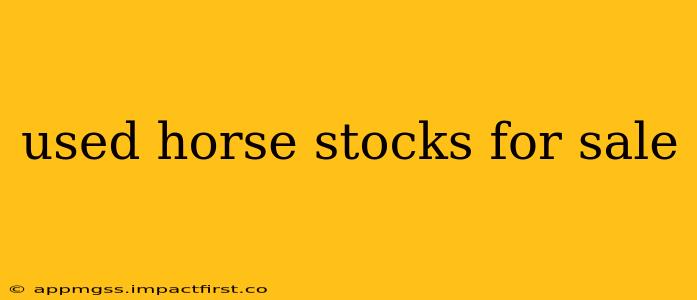Finding the right horse stock can be a significant investment, and buying used offers a cost-effective way to acquire high-quality equipment. Whether you're a seasoned equestrian or just starting out, understanding the market for used horse stocks is crucial. This guide will help you navigate the process, ensuring you find the perfect stock to meet your needs and budget.
What are Horse Stocks?
Before diving into the used market, let's define what horse stocks are. Horse stocks, also known as equine stocks or holding stocks, are devices used to safely restrain horses for various procedures like hoof trimming, veterinary care, and farrier work. They provide a secure and controlled environment, minimizing the risk of injury to both the horse and handler. Different types exist, varying in design, material, and level of restraint.
Where to Find Used Horse Stocks for Sale?
Locating used horse stocks involves exploring various avenues:
- Online Marketplaces: Websites like eBay, Craigslist, and Facebook Marketplace often list used equestrian equipment, including horse stocks. Be sure to carefully examine photos and descriptions, and ask the seller plenty of questions before committing to a purchase.
- Equine Forums and Groups: Online forums and social media groups dedicated to horses and equestrian activities are excellent resources. Members frequently buy, sell, and trade equipment, and you can find hidden gems this way.
- Local Tack Shops and Feed Stores: Many tack shops and feed stores act as brokers for used equipment, or they may have a consignment program. Check with your local businesses to see if they have any used horse stocks available.
- Auction Sites: Livestock and farm auctions often include equestrian equipment. This can be a good option for finding deals, but thoroughly inspect the stock before bidding.
What to Look for When Buying Used Horse Stocks
Inspecting a used horse stock thoroughly before purchasing is paramount:
- Structural Integrity: Check for any signs of damage, cracks, or weak points in the wood or metal frame. Ensure all bolts and screws are tight and secure.
- Safety Features: Verify that all safety features are in working order and undamaged. This includes latches, releases, and any padding or cushioning.
- Cleanliness and Hygiene: A well-maintained stock will be clean and free of debris, manure, and excessive wear. Consider the hygiene implications, especially if the stock shows signs of significant use.
- Size and Fit: Ensure the stock is the appropriate size for the horses you'll be using it with. A stock that's too small or too large can be dangerous.
How Much Do Used Horse Stocks Cost?
The price of used horse stocks varies greatly depending on factors such as:
- Brand and Model: Established brands often command higher prices, even in the used market.
- Condition: Well-maintained stocks in excellent condition will sell for more than those showing significant wear and tear.
- Type of Stock: Different designs and materials will impact the price.
What are the Different Types of Horse Stocks?
H2: What are the different types of horse stocks?
There are several types of horse stocks, each with its advantages and disadvantages. Common types include:
- Wooden Stocks: Traditional and often more affordable, wooden stocks require regular maintenance to prevent rot and damage.
- Metal Stocks: More durable and easier to clean than wooden stocks, but typically more expensive.
- Portable Stocks: Designed for easy transport and setup, ideal for travelling farriers or veterinarians.
- Fixed Stocks: Permanently installed stocks, usually found in larger stables or veterinary clinics.
H2: How do I maintain my used horse stocks?
Proper maintenance extends the life of your horse stocks and ensures their safe use. Regularly inspect for damage, clean thoroughly after each use, and lubricate any moving parts as needed. Wooden stocks require occasional treatment to prevent rot and cracking.
H2: What safety precautions should I take when using horse stocks?
Always prioritize safety when using horse stocks. Ensure the horse is properly restrained, and never leave a horse unattended in the stocks. Use appropriate handling techniques and be aware of the horse's temperament.
By carefully considering these factors and taking the time to thoroughly inspect any used horse stock you are considering, you can confidently make a purchase that meets your needs and enhances the safety and well-being of your horses. Remember that a well-maintained used stock can provide excellent value and serve you reliably for many years.
